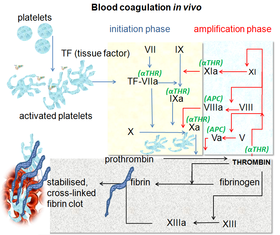| Thrombin time | |
|---|---|
 Blood coagulation pathways in vivo showing the central role played by thrombin | |
| Other names | TCT |
| MeSH | D013918 |
The thrombin time (TT), also known as the thrombin clotting time (TCT), is a blood test that measures the time it takes for a clot to form in the plasma of a blood sample containing anticoagulant, after an excess of thrombin has been added.[1] It is used to diagnose blood coagulation disorders and to assess the effectiveness of fibrinolytic therapy. This test is repeated with pooled plasma from normal patients. The difference in time between the test and the 'normal' indicates an abnormality in the conversion of fibrinogen (a soluble protein) to fibrin, an insoluble protein.[2]
The thrombin time compares the rate of clot formation to that of a sample of normal pooled plasma. Thrombin is added to the samples of plasma. If the time it takes for the plasma to clot is prolonged, a quantitative (fibrinogen deficiency) or qualitative (dysfunctional fibrinogen) defect is present.[3] In blood samples suspected to contain heparin, a substance derived from snake venom called batroxobin[4] (formerly reptilase) is used for comparison to thrombin time. Batroxobin has a similar action to thrombin but unlike thrombin it is not inhibited by heparin, so reptilase time and thrombin time can be used concurrently to distinguish anticoagulant effect from hypofibrinogenemia or dysfibrinogenemia.[1][5]
Normal values for thrombin time may be 12 to 14 seconds,[6] but the test has significant reagent variability. If batroxobin is used, the time should be between 15 and 20 seconds. Thrombin time can be prolonged by heparin, fibrin degradation products, and fibrinogen deficiency or abnormality. Thrombin time is not affected by anti-Xa anticoagulants such as rivaroxaban or apixaban, but is very sensitive to direct thrombin inhibitors including dabigatran, argatroban, and bivalirudin.[5]
- ^ a b David Lillicrap; Nigel Key; Michael Makris; Denise O'Shaughnessy (2009). Practical Hemostasis and Thrombosis. Wiley-Blackwell. p. 53. ISBN 978-1-4051-8460-1.
- ^ Popović M, Smiljanić K, Dobutović B, Syrovets T, Simmet T, Isenović ER (January 2012). "Thrombin and vascular inflammation". Molecular and Cellular Biochemistry. 359 (1–2): 301–13. doi:10.1007/s11010-011-1024-x. PMID 21858738. S2CID 14313728.
- ^ Hatton, Chris (2008). Haematology (Lecture Notes). Cambridge, MA: Blackwell Publishers. p. 156. ISBN 978-1-4051-8050-4.
- ^ Batroxobin factsheet
- ^ a b Mackie I, Casini A, Pieters M, Pruthi R, Reilly-Stitt C, Suzuki A. International council for standardisation in haematology recommendations on fibrinogen assays, thrombin clotting time and related tests in the investigation of bleeding disorders. Int J Lab Hematol. 2024 Feb;46(1):20-32. doi: 10.1111/ijlh.14201. Epub 2023 Nov 20. PMID: 37984807.
- ^ Hoffbrand, A. V. (2002). Essential haematology. Oxford: Blackwell Science. p. 248. ISBN 978-0-632-05153-3.